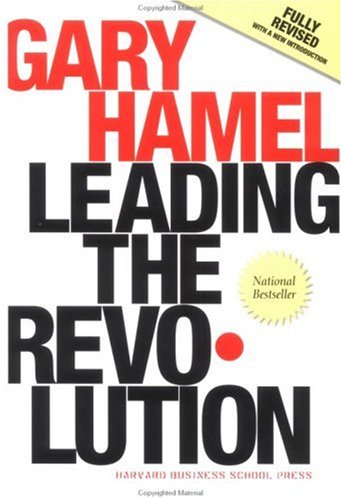Gary Hamel, "Leading the Revolution: How to Thrive in Turbulent Times by Making Innovation a Way of Life"
Harvard Business Press | 2002 | ISBN: 1591391466 | 336 pages | PDF | 12,2 MB
Harvard Business Press | 2002 | ISBN: 1591391466 | 336 pages | PDF | 12,2 MB
Amazon.com Review
So much for the old economy, new economy divide. According to Gary Hamel, the professor-turned-strategy-guru author of Leading the Revolution, complacent establishment giants and one-strategy start-ups are on the same side of the fence–the wrong side. Corporate complacency and single-strategy business plans leave no room for what Hamel describes as the key to thriving in today's world of business: a deeply embedded capability for continual, radical innovation.
Leading the Revolution is not a calm analysis of what will or won't work in a post-industrial world. Instead, it's an impassioned call for revolutionary activists to shake the foundations of their companies' beliefs and move from a linear age of getting better, smarter, and faster, to a nonlinear age of becoming different. While in the past incremental improvements in products and services were accepted as good enough, Hamel shows that true innovation is the demolition and re-creation of an entire business concept. He blows apart the popular myth that innovation lies solely in the hands of dot.com dynamos like AOL and Amazon by scrutinizing the examples of such "gray-haired revolutionaries" as Enron and Charles Schwab, companies that have managed to reinvent both themselves and their entire industries, time and again.
After an in-depth examination of what business-concept innovation involves (for starters, it's "based on avoidance, not attack"), Hamel goes on to motivate his readers to see their own revolutionary future, and train them in the art of being an activist. As he puts it in various headings, be a novelty addict, be a heretic, know what's not changing, surface the dogmas. And then get out there and transform your ideas into reality. Not simply a round-up call, Hamel's book provides would-be activists with an intelligent, comprehensive plan of action. He illustrates each imperative with examples of real-life corporate rebels, such as John Patrick and David Grossman at IBM, Ken Kutaragi at Sony, and Georges Dupont-Roc at Shell. His message is the same to "old" and "new" companies alike: "Industry revolutionaries are like a missile up the tail pipe. Boom! You're irrelevant!" So join the revolution and avoid the explosion.
Hamel writes in a clear and compelling voice, preaching with passion but supporting what he says with detailed, experiential evidence. Each chapter is packed with probing questions and inspirational examples that aim to dig through the apathetic corners of your mind and throw hand grenades into any creative synapses still slumbering. Even the alternative (read innovative) design of Leading the Revolution will jolt you into a new level of awareness and imagination. Indeed, the only problem you might have with this book is an increasing desire to put it down before the end, get out there into the wild world of the activist, and start living the revolution. –S. Ketchum –This text refers to an alternate Hardcover edition.
From Publishers Weekly
Hamel's first edition of this volume, published in 2000, urged managers help lead a business revolution by embracing change-developing e-commerce, participating in joint ventures and engaging in selective cooperation. Centuries of incremental progress have given way to a time of revolution, Hamel argued, and companies must change or die. His revised version keeps the focus on far-reaching innovation-imagine the kind of future you want for your company, Hamel urges, and then go out and create it-but he makes sure to dismiss the "helium" of the dot-com bubble and focus on meaningful business change. He highlights Cemex, the third largest cement company in the world, as proof that "new attitudes and new values can change an old industry"; UPS, too, gets the nod as another "gray-haired revolutionary." (Unsurprisingly, Hamel's positive Enron profile from the earlier edition gets the axe.) Hamel's presentation is powerful and his core argument that corporate leaders must be more entrepreneurial remains convincing; the worst that can be said about this volume is that, by rehashing his earlier writings, Hamel may not be fully following his own advice.
Not all books on AvaxHome appear on the homepage.
In order not to miss many of them follow ebooks section (see top of each page on AH)
and visit my blog too :)
In order not to miss many of them follow ebooks section (see top of each page on AH)
and visit my blog too :)
NO MIRRORS according to the rules



